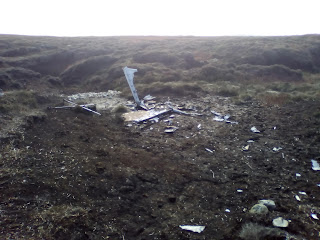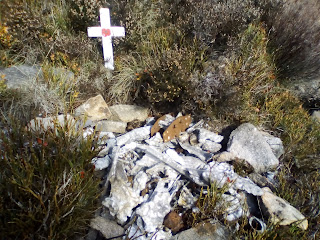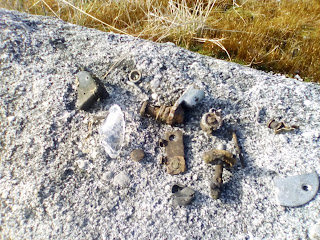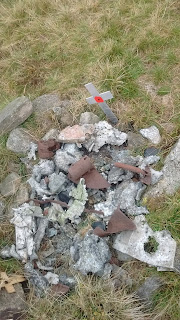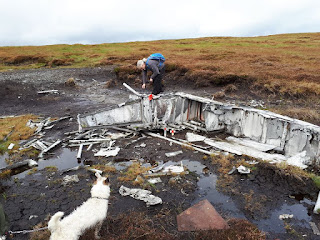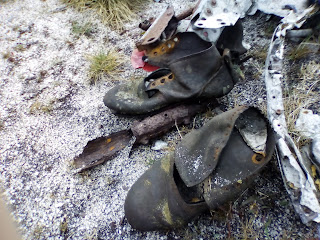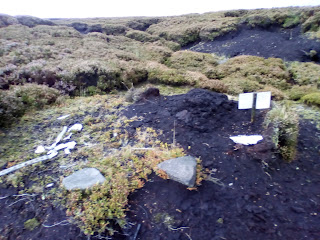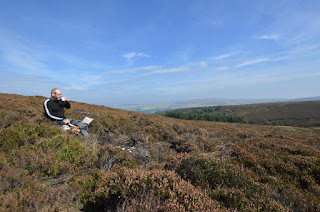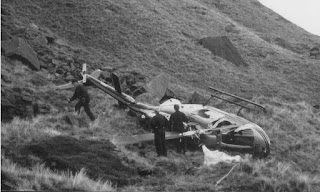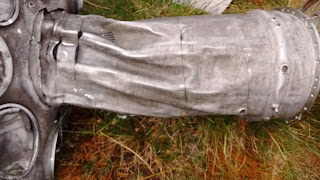Monday 22 October 2018
Handley-Page Halifax HR727
Great weather last Saturday for an outing with Matt ZX on Kinder.
We only saw two of the wreckage piles we found back when we were looking for this and the nearby Wellington on the day, but we didn't search at all of the old coordinates. Feel free to look for yourself and get back to me...
This is the largest of the three Halifax wreckage piles we found back then. All looked pretty much as before.
Location: SK 13102 87633
Labels:
Halifax,
handley page,
kinder,
scout
Location:
Kinder Scout, High Peak SK22 2LJ, UK
Armstrong Vickers Wellington Mk.III X3348 coded ZL-Z
Less wreckage and more scattered than before, but this Wellington crash site is still recognisable by the geodetic. If you recognise geodetic that is.
Location: SK 12807 87554
Armstrong Vickers Wellington W5719
Location: SK 11062 87549
Labels:
Armstrong,
kinder,
scout,
vickers,
wellington
Location:
Kinder Scout, High Peak SK22 2LJ, UK
Avro Anson Mk.XI NL185
Still two engines and lots of skinning at this crash site, which seems just as last time other than the homemade cross being absent.
Mat found some interesting bits, which you can see on his blog. I've put his pic of the most complete engine up, without the sepia filter Mick used last time.
Location: SK 08874 86578
Location:
Kinder Scout, High Peak SK22 2LJ, UK
De Havilland Dragon Rapide G-ALBC
There seemed to be about as much stuff at the site as last time, though it had all moved around as usual.
Matt found a few interesting bits....
Location: SK 10160 88245.
Labels:
dragon rapide,
kinder,
peak district crash,
scout
Location:
Kinder Scout, High Peak SK22 2LJ, UK
Handley Page Heyford Mk.III K6875
There has been lots of moving stuff around at this site, and there's a bit less than there was last time, but there wasn't that much to being with, at least during the time I've been going to it.
Matt found a few buckles....
Location: SK 11093 86013
Labels:
handley page,
Heyford,
kinder
Location:
Kinder Scout, High Peak SK22 2LJ, UK
Monday 8 October 2018
Handley Page Hampden Mk.I AE381
Out on a training walk yesterday on Kinder, I dropped in on this site very close to the path. Both of the wreckage piles and their associated cross and plaque were disturbed, and one of those new stainless steel crosses I've been seeing has appeared, but the metal looks mostly still to be there, compared with my last visit in 2007.
The Kinder perimeter path was really busy, and there were already no parking spaces left in Edale at 7AM. I don't normally go there on a Sunday morning. I wouldn't recommend it, unless you like a crowd.
Location: SK 07802 87492.
Sunday 30 September 2018
Handley Page Halifax MkII DT578 Coded ZB?
A foggy day out on Great Whernside last week with Pat and MT Skull (in the fog behind me) resulted in bagging that elusive Halifax site, (after several previous failed attempts) and confirming the Mosquito and Fortress sites once more. Thanks MT!
As usual, evidence of scrap collection by sad anoraks since our last visits
Location: SE 00089 72955
Location:
Great Whernside, Skipton BD23 5RP, UK
Monday 17 September 2018
Blackburn Botha W5103
A grand day out with MatZX and GF last Saturday, as well as my "two nutter dogs"- one pictured.
Mat has a gift for spotting wreckage which means you always get some new stuff if you take him along, as proved to be the case at the weekend.
I haven't bothered showing pics of the main sites, other than this one, though they were all much as they were more than ten years ago, instead focusing on the extras details Mat is good at finding, I used his pics too...
This is the first one of the day, the Botha crash site on Bleaklow.
Location: SK 11077 97532
Labels:
Blackburn Botha W5103
Location:
Bleaklow, Glossop SK13 1JB, UK
Boulton Paul Defiant Mk.I N3378
The Defiant crash site at Near Bleaklow Stones was more or less as it was last time, though we found wreckage scattered downhill up to 300m away we hadn't noticed before, and the main wreckage pile had acquired these boots.
Location: SK 10618 96937.
Labels:
Boulton Paul Defiant Mk.I N3378
Location:
Bleaklow, Glossop SK13 1JB, UK
Bristol Blenheim Mk.I L1476
Mat found this wreckage pool and sign close to the Sykes Moor Blenheim site. We'd never seen it before. The main site and memorial were as they were last time I came
Locations:
Main site SK 08303 97004
Site pictured SK 0822 9694 (estimated)
Locations:
Main site SK 08303 97004
Site pictured SK 0822 9694 (estimated)
Labels:
Bristol Blenheim Mk.I L1476
Location:
Bleaklow, Glossop SK13 1JB, UK
De Havilland L-20A Beaver 52-6145
Recognizable bits from the Beaver site on the edge of Bleaklow overlooking Devil's Elbow, which is much as it was last time, except the rough wooden cross from our last visit has been replaced by a rough stainless steel one.
Location: SK 05533 97588
Location:
Bleaklow, Glossop SK13 1JB, UK
Thursday 6 September 2018
UK Air Crash Sites Photos
Here's my flickr site, with my archive of crash site photos. You can see grid refs/coordinates for all of the pictured sites on here.
Labels:
air,
coordinates,
Crash,
grid reference,
pictures,
site
Location:
United Kingdom
Monday 3 September 2018
Republic P-47D-1-RE Thunderbolts, 42-7872 and 42-7898
I had a great day out with Ian DB last Saturday on and around Shining Tor, near Macclesfield. All of the pics for these four sites are c/o Ian, who is a lot better at photography than I am. You can see more examples of this at his site here.
This pic shows the leading plane's impact crater. All of the wreckage seen last time is gone, though a bit of skinning and a new cross have replaced it. The nearby crater of the following plane no longer has any visible wreckage t all.
These two sites are a bit awkward to get to, well away from the path, over a fence and down some steepish roughish ground. There is no reason to suspect they are there is you don't know that they are. This is not the work of "curious walkers". It smells of anorak to me.
Locations:
SJ 99502 75395 (leading)
SJ 99502 75410 (following)
Location:
Macclesfield SK10 5XL, UK
Airspeed Oxford Mk.I LX745

Looking much as it did back in 2007, despite being very easily accessible from the nearby well-trafficked path, the Oxford site was the third of the four sites visited last Saturday. The pic shows the main wreckage pool. There is also a fuel tank partially buried nor far away.
Locations:
Wreckage pictured is at SJ 99800 74629.
Fuel tank at SJ 99813 74648.
Location:
Shining Tor, Macclesfield SK10 5XL, UK
Noorduyn UC-64A Norseman 43-35439
The disputed Norseman site looks much the same as last time we visited, and established that it was a US 'plane rather than Defiant Mk.I T3921, as some had claimed.
Location: SJ 99831 73579
Location:
Shining Tor, Macclesfield SK10 5XL, UK
North American Harvard Mk.IIB FT442
This Harvard site on Shining Tor is considerably more overgrown than when last visited, but it has acquired another one of those new crosses.
Location: SJ 99748 73741.
Location:
Shining Tor, Macclesfield SK10 5XL, UK
Thursday 16 August 2018
Bell 206B Jet Ranger Helicopter G-ODIL
Contrary to the assurances Pat received in the past from anoraks, there is in fact still authentic helicopter wreckage in William Clough. It wasn't even that hard to find.
Location: SK 06655 89697
Bell 206B Jet Ranger Helicopter G-ODIL
Yorkshire Helicopters 24 October 1997
Pilot: uninjured (and anonymous)
Newspapers, both local and national, asked not to divulge the pilot’s identity, chose to honour the request; neither is it Air Accident Investigation Branch policy to publish names. Helicopters have been widely employed in conservation and restoration work in the Peak District, one of their major tasks being to airlift stone slabs from redundant mills to be laid as paving in the style of the medieval ‘causey paths’ over the most boot-eroded sections of the area’s peaty tracks. Among other tasks have been the airlifting of fencing materials; of heather tops from lower moors for reseeding denuded moorland; and of water for fighting fires.
Hiring helicopters, although expensive, has proved to make economic sense, one of the many advantages being that the moors do not suffer the damage caused by surface vehicles. Indeed the ground was barely marked when Jet Ranger G-ODIL suffered a dynamic-rollover upset – effectively, tipping itself over – in the course of lifting stone from the shoulder of Ashop Head, at the summit of Kinder’s William Clough.
A first load, at an estimated weight of one thousand pounds, had been successfully lifted. However, the steep and restricted nature of the 1,750-feet-above-sea-level site had made it difficult to turn into wind, so that, without the assistance of the full wind speed, the helicopter had required its maximum torque to lift off, and then move forwards from the hover. Notwithstanding this, the second load proffered was even heavier; only then the pilot was quite unable to accomplish the transition to forward flight. He tried to set the load down again, but as a skid made contact with the ground a rolling motion was imparted and the helicopter, with its ability to respond to corrective lateral control now diminished, tipped onto its side.
The pilot was unhurt, but the machine sustained extensive damage and was eventually airlifted to the A57 at Doctor’s Gate. Although the aircraft was severely damaged it was not that badly fragmented and in 2006 Pat reported that nothing remained, certainly on the surface of the site, the few scraps of debris left behind after the clear-up operation having been taken to the Hayfield Ranger’s station near Bowden Bridge, where they were still to be seen.
North American F. Mk.4 Sabres (or are they Canadair CL-13s?) XD707 and XD730 :
Pat Cunningham (in the pic) offers the following information about the crash of two Sabres from No.66 Squadron, RAF Linton-on-Ouse, No. 12 Group, Fighter Command onto Kinder Scout and Black Ashop Moor on 22 July 1954 in which the formating pilots (Flying Officer James D. Horne, section leader (XD707) and Flight Lieutenant Alan Green, formating pilot (XD730)) were both killed.
So it was that on 22 July 1954, four of the No.66 Squadron Sabres were recovering to Linton-on-Ouse, near York, after a high-level interception sortie flown in the course of a major annual-evaluation war-game. For the descent, the formation leader had split his section into pairs, each pair entering cloud independently at 12,000 feet.
Some time later, as his pair passed 5,000 feet, still in cloud, the overall leader transmitted an advisory warning to Flying Officer James Horne, now leading the second pair, against descending below 3,000 feet on their present heading: the more realistic safety height of the future was to be 3,800 feet.
The foursome had noted already that Flying Officer Horne’s radio was weak at times, so he may not have heard the warning; certainly, he did not acknowledge.
Indeed nothing more was heard of him, or of his number two, until three days later when a walker came upon a body on The Edge, high above Black Ashop Moor.
Until this discovery bad weather had hampered the search, although the keeper of the Kinder Reservoir had reported being alarmed by two jet fighters roaring at very low level towards cloud-covered Kinder. Despite his concern, however, he had heard no subsequent impact.
These aircraft had undoubtedly been the two Sabres, although what made Flying Officer Horne take his number two that low will never be known. A likely scenario, however, is that he saw a clearance below him, and dropped into what turned out to be a ‘sucker’s gap’ – a beckoning clearance which then closed in around him. Certainly, in his evidently hasty pull for a safe height, he managed to clear the edge of Kinder, but equally evidently something untoward happened after he had done so, for both aircraft struck the ground in a single impact point not many yards into the plateau.
To conjecture further, although Flight Lieutenant Alan Green, the number two, was more experienced than his leader, he was still settling in having been posted from another squadron. It could be then, that, caught out by the hastily initiated transition from level flight to very steep climb, he had – understandably – twitched just that little bit, causing his wingtip to lock with his leader’s tail. Or what is equally likely, bearing in mind that both aircraft were in very steep climbing attitudes, is that, in reaction to his leader’s over-hasty pull, Flight Lieutenant Green had pulled even harder, got high, and being momentarily unsighted from his leader, had collided in blindly pushing back into position.
The court of inquiry, however, did not treat with such speculation, finding only that Flying Officer Horne, as section leader, had failed to observe the area safety height – which he should have been familiar with regardless of any missed transmission – although it found some little mitigation in his faulty radio. It specifically noted that no blame was to be attached to Flight Lieutenant Green, whose sole responsibility had been to formate upon his leader.
Locations
SK 06926 89664 Kinder: initial impact point, start of debris trail (illustrated above)
SK 07268 90236 Black Ashop Moor: wings, gear, with an engine in an adjacent grough
SK 07300 90100 Black Ashop Moor, two debris pools
SK 07548 90390 Black Ashop Moor, the second engine
I note that there is a lot less here then in my last pic. Theft and vandalism by sad anoraks as usual.
Labels:
Canadair CL13,
coordinates,
Crash,
grid reference,
sabre,
site
The North American F-86 Sabre and its Canadair version, the CL 13
Pat Cunningham has offered a bit of a blurb about the Sabre, and its Canadair development the CL-13:
In the early 1950s the British-designed replacements for the by-then outclassed Meteor and Vampire fighters were suffering many developmental problems, so the appearance early in the Korean War (1950-53) of the Soviet MiGs quite discomfited the Royal Air Force planners. Accordingly, in fulfilment of a mutual defence agreement, Canada made over to the RAF 431 Sabre jets.
Fortuitously, the RAF was not a total stranger to the swept-wing type, a few of its pilots having flown with the Americans in Korea, in the process shooting down a number of MiG-15 jets. The first of the F-86 Sabre series flew in late 1947, but the version the RAF received was a 1950s development with, significantly, in terms of performance, an all-flying tail. Powered by an Allison J47-GE-13 engine developing 5,200 pounds of static thrust, it had a maximum speed of 679 mph (590 knots) at sea level, an initial climb rate of 7,250 feet a minute, and a laden weight of 17,806 pounds.
Most pilots found the Sabre a delight to fly and many expressed disappointment when it was replaced by the Supermarine Swift and by the early marks of the Hawker Hunter. Just the same, by mid-1956 Hunters had completely replaced the RAF’s Sabres, both in Germany and in the UK.
In the early 1950s the British-designed replacements for the by-then outclassed Meteor and Vampire fighters were suffering many developmental problems, so the appearance early in the Korean War (1950-53) of the Soviet MiGs quite discomfited the Royal Air Force planners. Accordingly, in fulfilment of a mutual defence agreement, Canada made over to the RAF 431 Sabre jets.
Fortuitously, the RAF was not a total stranger to the swept-wing type, a few of its pilots having flown with the Americans in Korea, in the process shooting down a number of MiG-15 jets. The first of the F-86 Sabre series flew in late 1947, but the version the RAF received was a 1950s development with, significantly, in terms of performance, an all-flying tail. Powered by an Allison J47-GE-13 engine developing 5,200 pounds of static thrust, it had a maximum speed of 679 mph (590 knots) at sea level, an initial climb rate of 7,250 feet a minute, and a laden weight of 17,806 pounds.
Most pilots found the Sabre a delight to fly and many expressed disappointment when it was replaced by the Supermarine Swift and by the early marks of the Hawker Hunter. Just the same, by mid-1956 Hunters had completely replaced the RAF’s Sabres, both in Germany and in the UK.
Location:
Kinder Scout, High Peak SK22 2LJ, UK
Tuesday 14 August 2018
Short Stirling Mk.III LK502
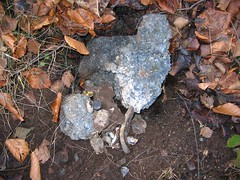
Stirling:Lake Rudyard
Originally uploaded by seansonofbig2
Previously molten chunks of aluminium, scraps, and a marked negative terminal at the impact site of the Stirling bomber which crashed near Rudyard Lake. There are also many scraps around this location, and an adjacent patch of bare earth riddled with minutiae. Hard to believe it hasn't been kept bare by generations of souvenir hunters scratching around for bits.
Location:SJ 93949 59825
More info
Labels:
aircraft,
lake,
peak,
peak plane wreck,
plane,
rudyard,
Stirling,
wreck,
wreckhunter
Tuesday 7 August 2018
North American F-86 Sabre F.Mk 4s XD707 + XD730: Kinder Scout Crash Site Vandalism
I've had time to a bit of wreck hunting again. For anyone who doesn't know, this blog is the site that published accurate coordinates for the crash sites on Kinder Scout, amongst other places. We are going to be doing this again, now that I have rebooted the site.
We went to the Sabre wreck sites on Kinder Scout yesterday. The more exposed of the two jet engines has acquired a number of saw cuts since I last photographed it.
It looks like people wanted to take some bits home. All illegal of course. People died at this site.
Location:
SK 07348 90256
Labels:
F-86,
jet engine,
kinder,
North American,
sabre,
scout
Location:
Kinder Scout, High Peak SK22 2LJ, UK
Subscribe to:
Posts (Atom)
